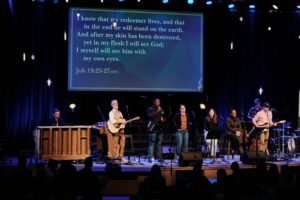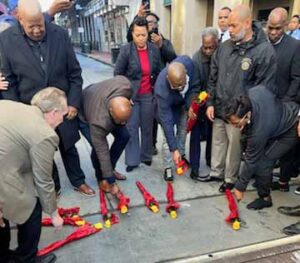
NASHVILLE, Tenn. (BP) — The Great Commission Resurgence that arose within the Southern Baptist Convention last year is being embraced by many state Baptist conventions as they restructure for greater efficiency and provide increased funding of missions and church planting efforts in North America and around the world.
[QUOTE@left@180=‘I think 27 of the 42 state conventions have either approved or are in the process of considering moving toward a 50/50 split in their CP giving.’
— Bryant Wright]What once appeared to be the biggest hurdle to accomplishing GCR priorities — state conventions shifting more of their undesignated Cooperative Program receipts from local churches for use beyond the state — is now a popular movement as nearly every state convention has increased the percentage forwarded to the SBC within the past five years.
“I think 27 of the 42 state conventions have either approved or are in the process of considering moving toward a 50/50 split in their CP giving,” said SBC President Bryant Wright, pastor of Johnson Ferry Baptist Church in Marietta, Ga.
“That’s a change in focusing on not keeping so many dollars in the state, but seeking to fulfill the Great Commission and taking the Gospel to those areas where there’s such a great need for that witness,” Wright told Baptist Press. “I’m really just amazed at how God is moving, and very thankful.”
Messengers in many of the state conventions adopted budgets designed to accomplish the GCR challenge to send the SBC a greater portion of CP receipts that will then be used to fund the International Mission Board (IMB) and North American Mission Board (NAMB) as well as six SBC seminaries, the Ethics & Religious Liberty Commission and SBC operations by the Executive Committee.
Many state conventions tightened their in-state budgets — some making dramatic cuts, such as the 44 percent reduction by New York Baptists in approving a $1.4 million budget for 2012 compared to $3.19 million in 2011. In spite of that change, the Baptist Convention of New York continues its incremental move toward splitting CP receipts 50/50 between the state and SBC causes, increasing the portion forwarded to 28.25 percent next year.
Twenty-four of the state Baptist conventions reduced their budgets, oftentimes reducing allocations to convention-related entities such as colleges, children’s and retirement homes and foundations in order to keep expenses in line with CP receipts from local churches. That was the case in South Carolina where seven institutions received significant cuts after CP giving decreased from $34 million in 2009 to an anticipated $28.6 million next year. The Northwest Baptist Convention eliminated 13 staff positions as part of their budget-cutting process.
Nine state conventions kept their budgets flat for 2012, while only six — Florida, Louisiana, North Carolina, Oklahoma, Tennessee and Southern Baptists of Texas Convention — approved increases.
Oklahoma Baptists approved the greatest increase in the percentage forwarded to the SBC, moving from 40 to 46 percent in one year, followed by Michigan Baptists increasing the SBC portion from 25 to 30.5 percent and New Mexico Baptists increasing the SBC portion from 30.5 to 35 percent.
The 2 percent-of-budget increase in CP giving to the SBC by Maryland-Delaware Baptists is in conjunction with a move to increase CP giving toward the year 2020, reaching the goal of keeping 49 percent in the state convention and 51 percent going to national and international causes. Reaching the goal is tied to churches increasing their giving.
Conventions approving increases in the portion sent for CP ministry beyond the state include Alabama (from 42.5 to 43 percent), Arkansas (42.57 to 42.77 percent), California (30 to 30.5 percent), Colorado (29.75 to 30 percent), Florida (40 to 40.5 percent), Indiana (36.5 to 37.5 percent), Maryland-Delaware (41 to 43 percent), Michigan (25 to 30.5 percent), Minnesota-Wisconsin (13.5 to 14 percent), Mississippi (35.25 to 36.25 percent), Missouri (37 to 37.25 percent), Nevada (30 to 30.5 percent), New England (21.75 to 25 percent), New Mexico (30.5 to 35 percent), New York (28 to 28.25 percent), North Carolina (35 to 35.5 percent), Northwest (25.5 to 26.5 percent), Oklahoma (40 to 46 percent), Penn-Jersey (25.3 to 25.4 percent), Tennessee (40 to 40.25 percent) and Wyoming (32.5 to 32.75 percent).
In a number of cases, increases in the portion to be allocated to the SBC will be figured after deducting items deemed to be “shared ministries” of the state convention and SBC.
Oklahoma Baptists followed a GCRTF recommendation to move toward a 50/50 split of Cooperative Program receipts with the SBC after consideration of allocations for shared ministries. In the new $24.9 million budget total, $3.1 is designated for shared ministry causes between the SBC and Baptist General Convention of Oklahoma, with the remaining percentage divided 46 percent to the SBC and 54 percent to remain in Oklahoma. In 2011, the BGCO forwarded 40 percent to SBC causes.
“This actually allows us to send $65,000 more to the SBC,” according to Doug McClure, finance committee chairman and pastor of First Baptist Church in Hugo, Okla.
The division of CP receipts will remain unchanged for 2012 in Alaska (33 percent), Arizona (26.05 percent) Dakotas (16 percent), Illinois (43.25 percent), Iowa (20 percent), Kansas-Nebraska (32 percent), Kentucky (43.54 percent), Louisiana (36.49 percent), Montana (22 percent), Ohio (40.25 percent), South Carolina (41 percent), Texas-BGCT (21 percent), Texas-SBTC (55 percent), Utah-Idaho (25 percent), Virginia-BGAV (34 percent in one of three pre-set giving tracks), Virginia-SBCV (50.75 percent) and West Virginia (38 percent).
Several states endorsed challenge budgets that, if reached, will be divided 50-50 between the SBC and the state convention, including Alabama, Arkansas, Illinois, Louisiana, Nevada and Tennessee. The two newest state conventions achieved or surpassed the 50/50 split early on — the Southern Baptists of Texas Convention forwards 55 percent to the SBC while retaining 45 percent for in-state missions and ministry. The Southern Baptist Conservatives of Virginia forwards 50.75 percent to the SBC while retaining 48.25 percent for in-state missions and ministry.
Churches in every state are being challenged to increase CP giving by 1 percent of their budget, a proposal that l17 pastors in Illinois agreed to promote to their churches for 2012. The Executive Board of the Baptist Convention of Pennsylvania-South Jersey affirmed the 1% CP Challenge in their official report. Anticipating a similar challenge from a study committee in South Carolina, 31 congregations pledged to raise CP giving by 1 percent or more next year.
Some states responded to task force reports that echoed some of the themes of the SBC’s Great Commission Resurgence Task Force.
Alabama’s meeting theme of “Great Commission Ministries Together” underscored a strategic partnership strategy that begins in 2013 to connect missionaries from Alabama with the International and North American mission boards with other Alabama Baptists.
California’s Focus 21 Task Force offered their report a year early, recommending how Southern Baptists in the state could more efficiently focus their efforts to fulfill the Great Commission. In spite of several messengers voicing objections to the move toward a 50/50 split of CP receipts, the motion was approved to refer the report for implementation to the convention’s executive board, passing with the support of 70 percent of those voting. In addition to the 50/50 split of CP funds, other recommendations relating to GCR include clarifying what constitutes a cooperative church and prioritizing church planting to receive a fourth of the budget funding.
Colorado messengers, with the approval of a task force report, affirmed streamlining staff and expenses to release more funds for church planting and ministry. Restructuring Task Force chairman Bob Bender of Black Forest, Colo., described the “mid-course directional change” as moving the ministry emphasis from the convention office to the local churches and associations.
“It streamlines staff and expenses,” Bender said, “to release more funds for church planting and ministry resulting in greater stewardship of monies. It focuses statewide efforts on doing fewer things better. It re-emphasizes the priority of prayer in achieving our vision.”
Noting that he is “driven by an unquenchable passion” for the Great Commission, D.C. Baptist Convention Executive Director Ricky O. Creech related in a recent report that he will begin a dialogue about the future focus of the D.C. convention, “pushing for a grassroots movement focused on adding value to the relationship of the Convention and the local church.”
Of the 37 proposals developed in response to Florida’s GCR Task Force formed last year, five were presented for a convention vote and were approved with little discussion. A seven-year CP budget plan will achieve the 50/50 split of CP funds by 2018. The original motion indicated the 50/50 split would occur after “shared ministries” of both Florida Baptists and the SBC were allocated, but an amendment in the State Board of Missions the day before messengers were to consider the plan removed “shared ministries” and incorporated that funding within the state convention portion of the budget.
The amendment urged every Florida Baptist church to increase CP giving to a sacrificial level while attempts were made from the platform to clarify the 50/50 split is not contingent on increased CP giving by the churches.
Georgia Baptists approved the report of a GCR Task Force that emphasizes spiritual renewal, Kingdom generosity, church revitalization, church planting and authentic evangelism.
In Montana, the 2020 Vision report initiated last spring will move the state’s Baptists toward a goal of sharing 30 percent of CP receipts with the SBC by the year 2020 while also focusing on the needs to penetrate lostness, engage in missions at home and abroad and cooperate in denominational effectiveness.
“No matter what one may think about the 20/20 Vision Report, we who are Christ-followers cannot ignore the desperate spiritual condition of the people in our communities and state,” Montana Southern Baptist Convention Executive Director Fred Hewett said following the meeting. “Montana Southern Baptists must respond with urgency to make this mandate our priority,” he said, making the appeal to “roll up our sleeves and work together.”
Nevada Baptists heard reports from their Executive Board concerning compliance with a restructuring approved the prior year, merging the state’s four associations and state convention into one organizational and administrative structure.
South Carolina Baptists approved the report of a Great Commission Resurgence Task Force, increasing contributions to the International Mission Board by nearly 22 percent over the next three years and moving toward a 50/50 split of CP receipts over the next five years. Church revitalization, missions mobilization/evangelism and church planting will be the primary focus of the state convention.
In West Virginia, a reorganization plan adopted by a 60/40 margin puts a sharper focus on prayer and church planting by the state’s Baptists. The portion of CP receipts sent beyond the state to SBC causes will grow from 38 to 40 percent by 2013, followed by a 1 percent increase each year for 10 years.
Several states emphasized responsibility for reaching lost people in their own states, including Arizona with its call for “a culture of accountability” in fulfilling the Great Commission and Colorado Baptists resolving to work together in assisting local churches in saturating the state with the Gospel. Florida Baptists, in approving “Revision Florida,” also set a priority on a greater release of resources in order to refocus on Great Commission efforts.
New York Baptists approved a motion to establish a task force to develop a vision and strategy that will encourage churches and associations to evangelize lost people, strengthen and plant churches and accomplish the Great Commission. Task forces were launched in the Pennsylvania-New Jersey state convention and Dakota Baptist Convention to evaluate the future course of their ministries.
“There are a lot of unknown things,” acknowledged Dakota Baptist Steve Ford of Vermillion, S.D. “We’re going to find we’re standing on the solid rock.”
A few state conventions voiced frustration that the GCR Task Force’s promise of more resources to the under-reached and underserved areas of North America was in conflict with decisions of the North American Mission Board to lower its level of funding in their states.
With a state population exceeding 11 million, Ohio Baptists are striving to reach 1 million people with the gospel by 2020, and passed a resolution asking NAMB to reconsider its decisions that “threaten a potentially disastrous impact upon the unified mission effort” of churches and associations in the state. The anticipated loss of $3 million is a result of NAMB changing the percentage of funding for Mission Ohio from 62 to 50 percent, expecting Ohio Baptists to increase their commitment from 38 to 50 percent.
As in Ohio, West Virginia messengers approved a resolution asking NAMB to continue funding for missionaries in the state. New Mexico Baptists heard from Executive Director Joseph Bunce about “seismic shifts” in Baptist life, including the impact of reduced NAMB funding that requires the state’s Baptists to become more responsible for the future of their convention.
New Mexico Baptists rose to applaud a resolution urging the SBC and LifeWay Christian Resources to insure that the conference center at Glorieta “continue its vital ministry.”
David Waltz told Penn-Jersey Baptists of an idea of altering the convention structure to include regions divided equally by population. As executive director of the two-state convention, Waltz called the “radically new and different way to do our work” a direction in which he believes God is leading their state in light of NAMB funding cuts.
In order to match funds promised by NAMB for church planting, Minnesota-Wisconsin churches are being challenged to increase their giving through the convention. The annual meeting theme of “All 4 One and One 4 All” was carried over from a series of one-day meetings conducted by MWBC Executive Director Leo Endel in each association this year. During those meetings, he explained the importance of the Cooperative Program and challenged churches to commit to increase their missions giving percentage by 1 percent each year for the next three years — .75 percent a year through the Cooperative Program and .25 percent a year to their association.
Endel said the response to the meetings was positive and many churches are considering increasing their CP and associational giving.
Wright, in his comments to Baptist Press, said the movement of state conventions to forward more CP dollars beyond their borders is a motivation to the local churches to increase their own CP giving, as well as contributions to mission offerings and all Great Commission causes benefiting the SBC.
“It certainly gives churches a greater motivation to do so in seeing a higher percentage of their dollars are going outside the state and especially to areas where the witness for Christ is either nonexistent or very weak.”
Wright concluded, “It’s a dramatic step in the right direction that I’m very thankful for.”
–30–
Tammi Reed Ledbetter is news editor of the Southern Baptist TEXAN and a correspondent for Baptist Press. Get Baptist Press headlines and breaking news on Twitter(@BaptistPress), Facebook(Facebook.com/BaptistPress) and in your email(baptist.press.com/SubscribeBP.asp).













